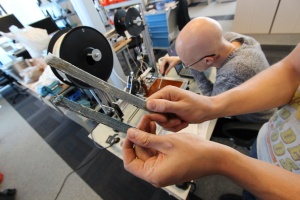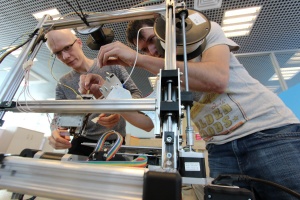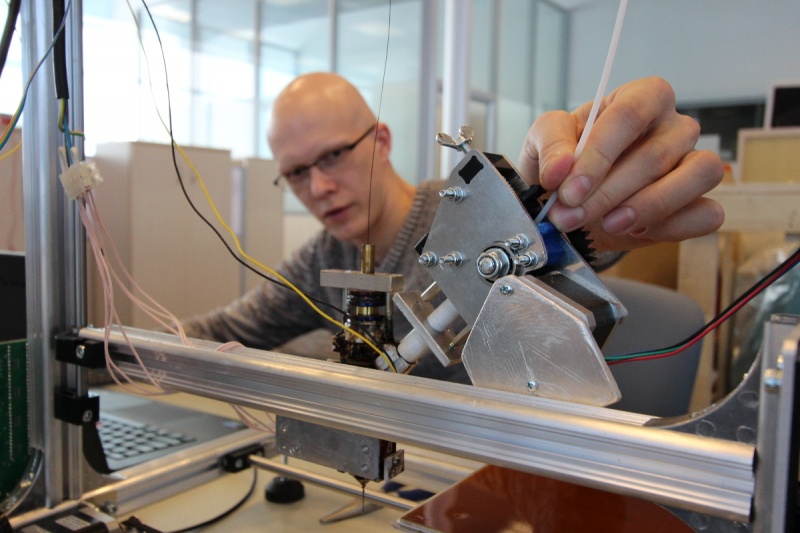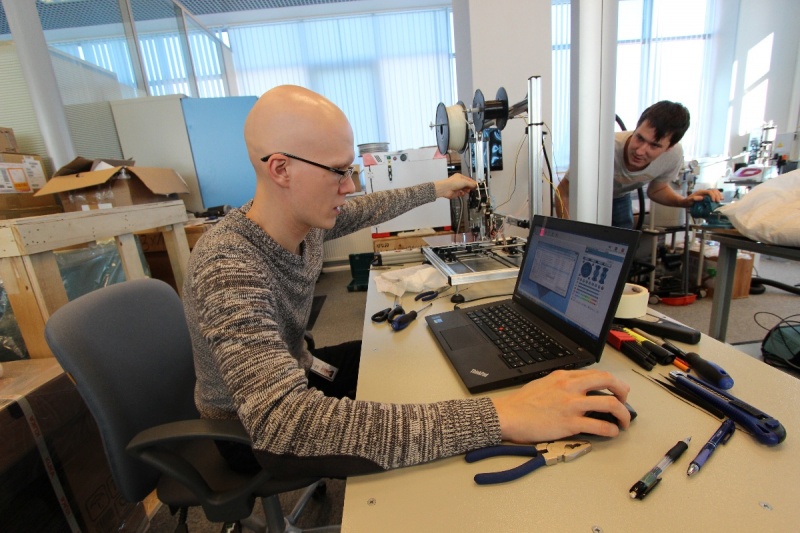
Researchers at The Skoltech Center for Advanced Structures, Processes and Engineered Materials (ASPEM) produced a composite material which is arguably “the strongest 3D printed fiber-plastic in the world.”
Press release, 19.02.2015
At midday the Skoltech composite materials laboratory is a busy yet quiet hive of activity. Researchers and assistants are typing away at their laptops, their faces wearing an impression of unflinching studiousness. There is no discernible office chit chat. In the midst of the hushed space, under the watchful eyes of the lab’s senior research scientist Fedor Antonov and Mikhail Golubev, a design engineer, a 3D printer is patiently mixing carbon fiber and thermoplastic resin. The two scientists fiddle with the machine’s extruder. Then the printer spews out a thin line of material. “Take a look”, Antonov presents the elongated rectangle. “It is an incredibly resilient and very strong composite material.”
His voice is laced with contentment like that of a proud father.
“This humble piece is possibly the strongest 3D printed fiber-plastic in the world. And we know how to make more of this stuff.”
For the last twenty years, the quest for the design and production of stronger and more flexible composite materials has attracted the imagination of business and research leaders. Composites’ wide range of applications, from medicine through aerospace to toys, made these unique materials increasingly important.
Researchers at The Skoltech Center for Advanced Structures, Processes and Engineered Materials (ASPEM) began their journey towards producing what is arguably a revolutionary material – with a challenge from their chief. Prof Zafer Gurdal, the center’s director, who moved to Moscow after working with the University of South Carolina, encouraged his students at USC and Skoltech to produce 3D printed materials. The team envisioned a groundbreaking method to impregnate carbon fibers with thermoplastic resins and to achieve exceptional fiber-plastic bonds and high adhesion levels. A Russian government grant bought the scientists time, but not success.
“At first we failed. Then we failed again and again and again”, Antonov reminisces, “the main problem with this technology is to achieve good quality of material: less porosity, better bonding between components, better fiber alignment. But eventually we got it right and came up with a completely new way to cover the fibers with a special chemical agent, which forms the durable interface between the components of the composite material. Our invention is special because of the way we treat carbon fiber tow (the packaged form of individual spools).”

At the Skoltech composite lab, senior research scientist Fedor Antonov (right) and Mikhail Golubev, a design engineer, operate a 3D printer which produces a stiff and resilient composite material. The Moscow based team of researchers now aims to register an international patent.
But that secret ingredient was not enough to create the final unique concoction. A new design for the printer’s extruder – which mixes fiber and plastic prior to deposition – was also required. The results, researchers claim, might be twice stronger and stiffer than that produced by MarkForged, an American company which claims to be the world’s first carbon fiber 3D printer. Now the ASPEM team is racing to register an international patent on the new material and its manufacturing process.
“We are very enthusiastic about the future of the project,” says Antonov, “we have a patentable idea and a working prototype, which can print very strong and stiff parts.”
And what is that good for? Which applications do you foresee?
“We might be able to extend the application of 3D printers from prototyping to real structural parts, having locally optimized geometries and material properties.”
So this is useful for manufacturing toys, car parts or plane components?
“You can print parts for UAV drones, quadro-copters and robots, impellers which are used at centrifugal pumps, or casing for drills. You can print orthopedic insoles for your shoes, or belt brackets. You can even print a non-bending cover for your iPhone 6 Plus. But these are all small parts. In the future we believe this will become a useful technology for the aerospace industry. And that is going to be a very significant development. We can hardly wait for the next phase.”

Mikhail Golubev, a design engineer, operating and controlling a 3D printer at the university’s composite materials lab.

Senior research scientist Fedor Antonov (right) and Mikhail Golubev, a design engineer, are part of a team of researchers at the Skoltech Center for Advanced Structures, Processes and Engineered Materials (ASPEM) which 3D printed a stiff and resilient composite material.
Contact information:
Skoltech Communications
+7 (495) 280 14 81
